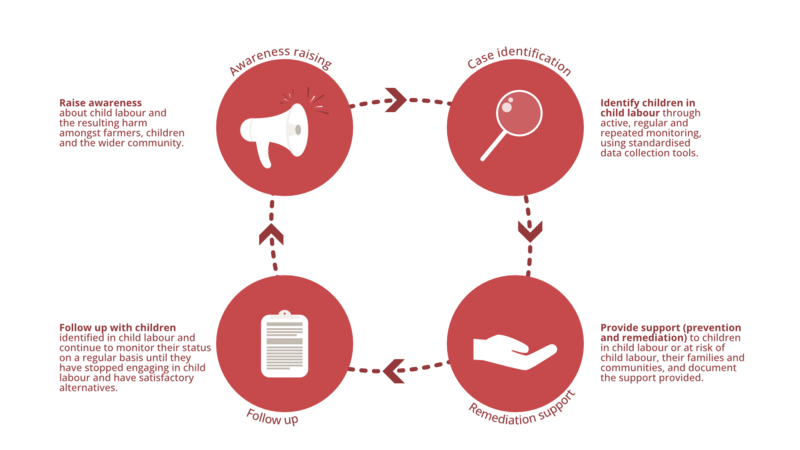Tackling child labour
Child labour remains a prevalent and pressing issue in cocoa farming, especially in West Africa. The members of the Swiss Platform for Sustainable Cocoa are committed to actively eliminating the root causes of child labour.
What is it about?
Many families who grow cocoa depend on the work contribution of children and adolescents. This is because the vast majority of households are affected by multidimensional poverty, especially in West Africa. As a result, most cocoa farmers cannot afford to hire external labour. In addition, schools in the mostly rural cocoa-growing regions are not always accessible on foot and families are often unable to pay for school uniforms, textbooks and other associated costs. In times of labour shortage, such as during harvest times, children and adolescents therefore often help out on the farms instead of going to school regularly.
What is child labour?
Studies have shown that most children who work on cocoa farms do so within their immediate or extended families. Not all of this work counts as child labour. Light and non-hazardous work that children do on their family’s farm for a limited time and without interfering with their schooling is internationally accepted. Such activities can contribute to the development of children and adolescents by providing them with skills and experience that help prepare them for future work in agriculture. However, if the work performed adversely affects a child’s health, development or education, it is unacceptable under internationally agreed conventions (incl. ILO Conventions 138 and 182). Accordingly, potentially hazardous activities such as carrying heavy loads, using sharp tools, spraying chemicals, or the work taking too many hours and/or interfering with a child’s school attendance, are considered child labour and are therefore not permitted.
How can child labour be addressed?
To effectively prevent and address child labour, it is important to combine approaches both at the national and community levels and to address the causes and consequences with a systemic approach. This means that measures to combat child labour should always be grounded in the relevant geographical, socio-economic and cultural context, and must make sense to families and communities. Concrete measures include raising awareness among families and village communities, identifying children who are engaged in child labour, and providing prevention and remediation measures for children and young people who are affected and/or at risk. Such prevention and remediation measures include promoting birth registration, enabling school attendance and adolescent skills development, promoting gender equality, and activities to increase the income of farmers.
A classic approach to combating child labour is the so-called CLMRS (Child Labour Monitoring and Remediation Systems) approach. It provides for the identification of children in child labour, the implementation of remedial measures including follow-up, and awareness-raising work to be carried out on a cyclical basis.
Building on national programmes
Another crucial measure is to increase cooperation with local authorities and recognise the importance of national child protection policies and programmes. Preventing child labour and forced labour is primarily the responsibility of state social and child protection policies and programmes. Private and public-private interventions should therefore always be built on the basis of existing national systems in order to increase local government ownership of the approaches and thereby ensure long-term sustainability. Systemic or even territorial approaches (so-called landscape approaches) are also beneficial to strengthen cross-sectoral cooperation and help prevent child labour from being merely shifted from the cocoa sector to another sector.
The goals of the Cocoa Platform according to the Roadmap 2030
Members of the Cocoa Platform have jointly set the following targets by 2030 in child labour:
- All members who are active in countries of origin with an incidence of child labour in cocoa production contribute to eliminating the root causes of child labour and thus child labour and to improving the perspective of young people.
- The Cocoa Platform engages in sustainable cocoa-sourcing landscapes involving efforts to tackle child labour effectively. Two landscape approaches are to be implemented by 2025.
- The Cocoa Platform signs and operationalises cooperation agreements aimed at child labour prevention with local authorities and, where appropriate, with multilateral organisations such as ILO, UNICEF, and development banks.
Learn more about the Roadmap 2030
Selected projects in child labour
Various members of the Cocoa Platform are implementing projects to combat child labour. These projects received a contribution from the State Secretariat for Economic Affairs (SECO) thanks to the mediation of the Coordination Office.
Tackling Child Labour and Enhancing Youth Opportunities in Ghana
This project aims to build a proof of concept to tackle child labour through a multisectoral, public-private partnership approach. The project aims to enhance governance, strengthen public finance management, harmonise child labour monitoring systems and improve integrated social services. It aims to promote positive social behaviour change in communities and the private sector and empower youth with skills and employment opportunities. Learn more about the project

